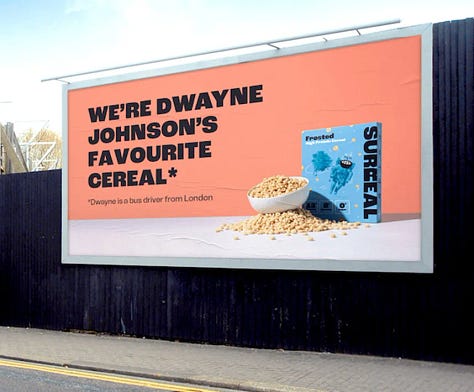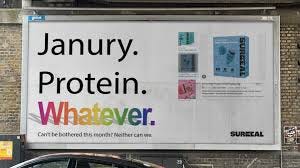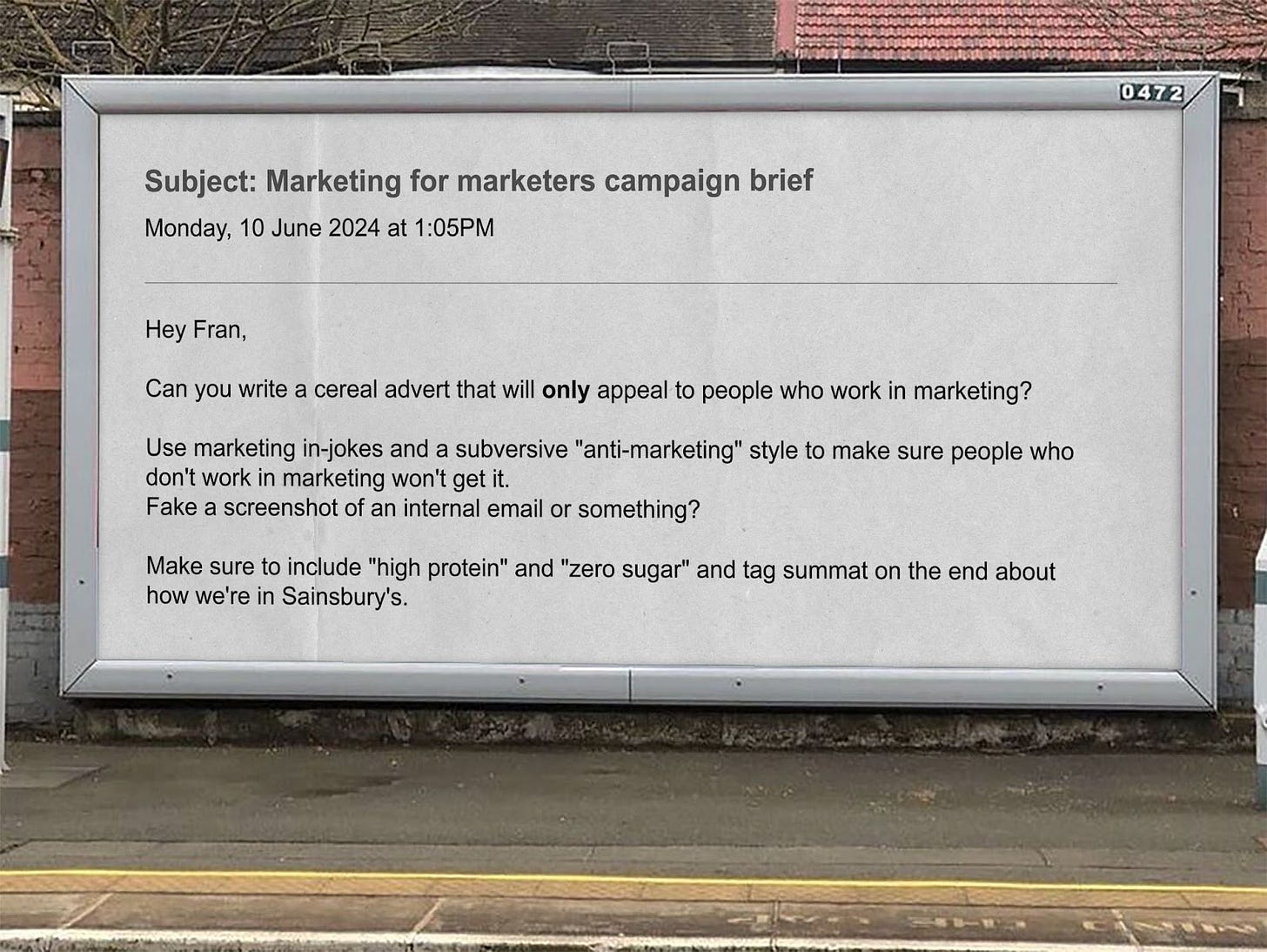How Surreal Built a Brand using Clever Positioning, Tone of Voice and Attention to become the Fastest Growing Cereal Brand in the UK and Break into a $40B Industry in 2 Years 🥣
Talk about eating the competition for breakfast 🥣
How Surreal Built a Brand using Clever Positioning, Tone of Voice and Attention to become the Fastest Growing Cereal Brand in the UK and Break into a $40B Industry in 2 Years
👋 Hi, I'm Amanda. I'm a brand strategist and fractional CMO. I help founder-led businesses turn belief into brand—and brand into a strategic asset that works as hard as you do. I share weekly deep dives with actionable advice on brand building—plus interviews with the people in the trenches. I also work 1:1 with founders and teams. Book a chat here.
Who will love this
Frosted Flake fiends
Grownups who were once cereal loving kids
Challenger brand founders
Today
Good afternoon.
Today’s letter is about a brand-spankin’ new brand. It’s a good example of a challenger brand breaking into an established market. It’s also a masterclass in using positioning, tone of voice and attention to shape a brand that punches well above its weight to drive growth.
Surreal are high protein low carb cereal for adults. They have:
🎯 Used clever positioning to break into a $40B industry in just 2 years
📈 Gained 40,000 followers on LinkedIn in one year (give ‘em a follow, you won’t be sorry)
🏆 Become the fastest growing cereal brand in UK
🎨 Crushed visual and verbal identity from day dot
Pour yourself a bowl and let’s dig in. 🥣
Amanda
How product, positioning and attention work together to shape the challenger brand taking on Big Cereal 🥣
Surreal’s founders, Jac Chetland and Kit Gammell, launched Surreal in 2022 to address a lack of nutritious and low-sugar options in the cereal aisle. Every other cereal was full of flavor, full of personality…and full of sugar. But there was no low sugar option.
But instead of marketing based on the logical merits of low-sugar cereal (snoozefest), they dug into the nostalgia of eating cereal as a kid. Their whole brand strategy is basically: remind people of their childhood. You know: trinkets in your cereal box, colorful, playful mascots - fun.
Here’s how Surreal broke into the cereal market:
Business strategy 💸
The global cereal market is big business, at $40.3B in 2022 and projected to hit $53B by 2030. There’s also increasing demand for healthy or speciality cereal, like gluten free and diabetic friendly cereal. And Surreal is perfectly positioned to capture that demand.
Surreal got their start as a DTC business, but they didn’t stay that way. I think some DTC companies are so set on being DTC that they miss the benefit of retail. Surreal is now in Sainsbury’s and Whole Foods, on top of their subscription sales.
Brand strategy 🎯
Like any good brand strategy, Surreal’s brand strategy needs to support its business strategy, (sell more cereal). Surreal started as a DTC brand, so they needed traction to convince retailers to stock the cereal. But building a DTC company using digital ads alone is dangerous (rising CACs, you’re dependent on one channel). Surreal’s brand is one that people want to talk about - which brings cost of acquisition down and brand awareness up.
It worked: Surreal could demonstrate to retailers that they were bringing net new consumers into the cereal aisle. That means incremental purchase on top of the average cart value: an attractive proposition for a retailer.
Now - let’s be clear. Surreal has an excellent product. You cannot market your way out of a product that doesn’t have product market fit. They’ve got it. But they didn’t stop there: Surreal are investing in brand early on while nailing a smart distribution strategy. Smart brand and distribution strategies have compounding effects and are worth getting right.
So what are the ingredients of Surreal’s brand?
Positioning: Joyful breakfast cereal. Zero sugar. Low carbs. High protein. In the cereal world, it feels like there’s only two options: super sugary cereal and tastes-like-cardboard healthy cereal. Good positioning is part gut and part data. Surreal’s brings the nostalgia of your favorite childhood cereal together with the nutrition that adult you knows you need.
Positioning happens in the mind. The best brands come from listening to what people need, finding the space you need to hold in people’s minds, and creating a category around that positioning. Surreal’s crushing it.
Verbal identity: playful. Surreal’s voice is a bit like Liquid Death, Oatly, or Innocent Smoothies: you could probably cover up the visual and pick the brand from the tone of voice. Fun fact: Surreal’s writer was previously at Innocent Smoothies (known for their voice and viral stunts).
Verbal identity, in my opinion, is one of the simplest ways to be memorable. In the same way Oatly became the sarcastic oat milk brand or Innocent became the zany smoothie brand, Surreal is quickly claiming a unique voice in cereal.
Testing, testing, testing for attention. Surreal understands the value of attention. To quote Bill Bernbach, if your advertising goes unnoticed, everything else is academic. Baby brands without massive budgets who can wield attention well have a competitive advantage. Surreal has the benefit of counting former Innocent senior creative John Thornton among its early employees. But if you look closely, you’ll see that Surreal is constantly testing for attention and using what they learn to plan their next stunt. “Make it go viral” isn’t a strategy. Consistently getting people talking about breakfast cereal? That’s a strategy.
Thornton has brought Innocent’s strategy of generating “soft outrage,” into Surreal, starting with his resignation from Innocent, which had amassed 2.5M on LinkedIn. They done things like sell billboard space to their customers on Black Friday, ”vandalizing” a billboard with cardboard, and “accidentally” selling the boss’s car on the Surreal website.
 Tiktok failed to load.
Tiktok failed to load.Enable 3rd party cookies or use another browser
Something I found interesting as I was researching this brand was the link between Surreal and oil. Yes, oil. Founder Kit Gammell is son of Sir Bill Gammell, Scottish oil tycoon, and Kit’s brother, Mike, is the founder of Days, a non-alcoholic beer company. I think this is worth noting for the same reason Nick Asbury noted it here:
“Both Surreal and Days are part of that wave of Gen Z, voguish brands that like to talk about ‘authenticity’ a lot. There’s a sense of fourth-wall-breaking informality about them: ‘We’re nice people, not like those stuffy old traditional businesses!’ But when you look at the lineage, the Gammells of today are the direct inheritors of the investment banks or oil companies of the past, just in more casual clothes.”
Why does this matter? Brands have a history of papering over inconvenient truths, and brands have soft power. I think we should all be in the habit of interrogating brands, who’s driving them and who stands to benefit from their success. It’s worth reading Nick’s full post.
Brand marketing moves 💃
Pseudo-Celebrity endorsements. One of Surreal’s early campaigns featured a number of faux-celebrity endorsements. This functioned as an attention-grabbing way to get Surreal in front of people. Getting Ronaldo, Dwayne Johnson, Serena Williams and Michael Jordan to endorse your product on a budget? Improbable…but not impossible.
New Year's resolutions campaign. How do you stand out at the time everyone is making healthy new year’s resolutions? Surreal whipped up the type of slapdash clipart billboards that would strike fear in the heart of any graphic designer. Why? Attention. Surreal figured out what everyone else would be saying (‘new year, new me’ - boring) and said the opposite: “Can’t be bothered this month? Neither can we.”
Notella. To launch a chocolate hazelnut flavored cereal, Surreal got crafty. They crept right up to the legal line of what they could say. They pointedly did not name specific trademarked brands, instead hinting at the taste and name.






What can we learn from Surreal?
👯♀️ Hire for your brand. One of the interesting lessons here is to have the right people in your team. John Thornton is an absolute get for Surreal. If humor is part of your brand, hire a comedian or a writer who’s demonstrated they can write jokes. Or really - if voice is one of your distinctive assets, make sure you’ve got someone in the team who can write like heck.
✂️ Remove the red tape. It’s really clear when you look at Surreal’s marketing that they’ve empowered their marketing team to make decisions and ship work fast. Most teams don’t have this freedom. This is a lesson in what happens when you have the right people, a shared understanding of brand voice and the ability to ship work quickly.
🔁 Try, try again. Similar to the above, I think a big part of Surreal’s success comes from being willing to try things and not panic at the first sign that a piece of work hasn’t been a smashing success. If you scroll through Surreal’s LinkedIn, you’ll see they’re constantly trying new things. The more tests you ship, the faster you’ll hone in on things that really work.
That’s all this week!
P.S. Ever received 1 million spam calls after registering a domain name? I’ve received 18 calls today (after 16 yesterday). It’s infuriating. If you’ve got tips (beyond registering on the Do Not Call registry) - hit me up.
Amanda ✌️









